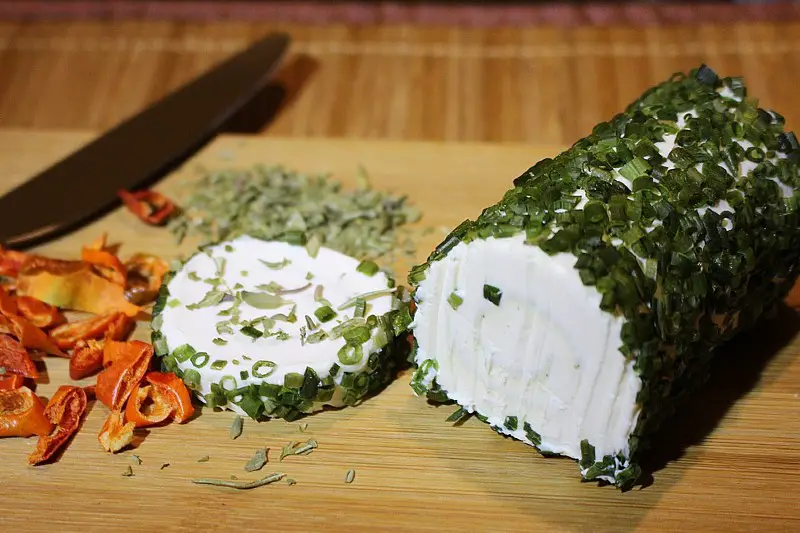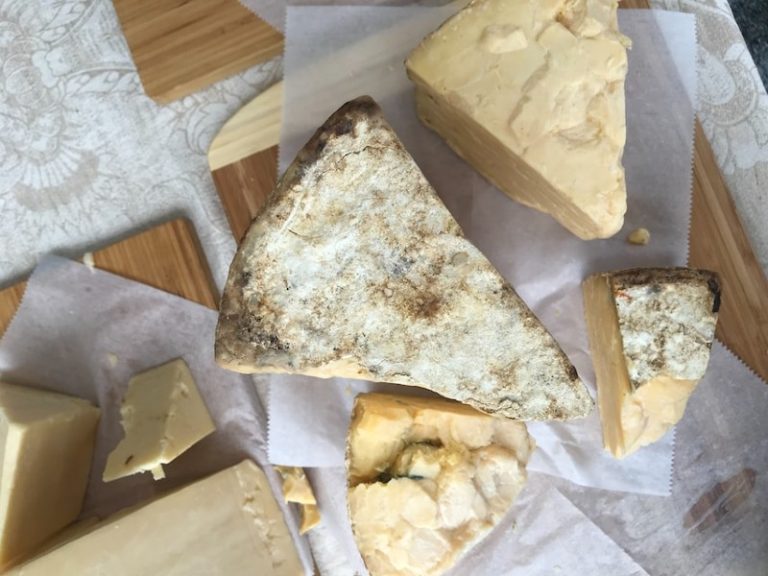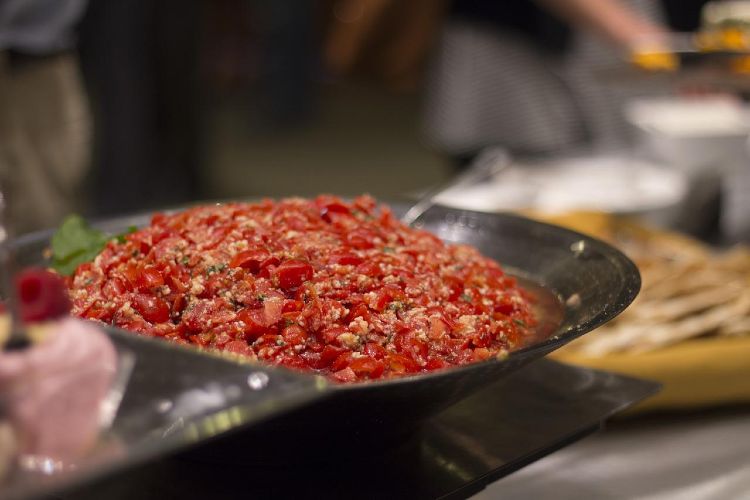What Does Goat Cheese Taste Like?
Quick Answer
The taste of goat cheese can vary but is generally tangy, tart, and earthy with a distinct “goaty” or “barnyard” flavor in some varieties. Fresh goat cheese is often soft and lemony, while aged versions can be more intense, nutty, and crumbly. The flavor profile can also include hints of sweetness or peppery notes depending on the aging process and specific production methods.
What Is Goat Cheese?
Goat cheese, also known as chèvre in French, is cheese made from goat’s milk.
It comes in various forms, including soft, spreadable fresh cheese to semi-soft, hard, and even blue-veined varieties.
The taste is generally tangy, tart, and earthy, and it can vary in flavor and texture depending on how it’s made and aged.
Goat cheese is widely used in cooking and as a table cheese, often featured in salads, spreads, and desserts, and it pairs well with fruits, nuts, and various types of wine and bread.
What Does Goat Cheese Taste Like?
The most immediate flavor characteristics that you’ll notice when tasting goat cheese are its tanginess and tartness. These qualities make it an instantly recognizable and unique kind of cheese.
The tartness often comes from the specific acids found in goat’s milk, which differentiate it from cow’s milk cheeses that may be more buttery or creamy.
The “Goaty” or “Barnyard” Undertones
A feature that sets goat cheese apart from many other cheeses is its “goaty” or “barnyard” flavor, which can be more pronounced in some varieties than in others.
These undertones can best be described as earthy and rustic, adding complexity to the cheese’s flavor profile.
Some people find this characteristic very appealing, giving the cheese a sort of authenticity, while others may find it to be an acquired taste.
Types of Goat Cheese and Their Taste
Goat cheese comes in a variety of forms, each with its own texture and flavor profile. Understanding these differences can help you make more informed choices when cooking or simply enjoying cheese.
Below are some common types of goat cheese and what you can expect in terms of both texture and taste.
Fresh Goat Cheese (e.g., Chèvre)
Fresh goat cheese, commonly known as chèvre, is usually soft and spreadable. The texture is creamy but can sometimes be slightly crumbly depending on the moisture content.
As for the flavor, fresh goat cheese is often described as light, lemony, and tangy. Because it’s typically not aged for long, it doesn’t have a strong, overpowering taste, making it ideal for salads or as a spread on crackers or bread.
Semi-Soft Goat Cheese (e.g., Drunken Goat)
Semi-soft goat cheese like Drunken Goat has a firmer texture compared to fresh chèvre but remains relatively soft and pliable.
Drunken Goat is often soaked in wine, which contributes to its unique, slightly sweet and fruity flavor. The cheese balances the tangy notes with more complex undertones, often with a smooth, almost buttery finish.
Hard and Aged Goat Cheese (e.g., Gouda-Style)
Hard and aged goat cheeses can be quite different from their softer counterparts. These cheeses are often crumbly and have a more concentrated flavor due to the aging process.
A Gouda-style goat cheese, for example, may have a caramel-like sweetness and nutty undertones. The texture is solid and can be easily grated, making it suitable for a variety of culinary applications.
Blue-Veined Goat Cheese (e.g., Valdeon)
Blue-veined goat cheese like Valdeon features the characteristic “blue” mold veins running through the cheese. The texture can vary from creamy to crumbly depending on the age and specific production methods.
Flavor-wise, blue-veined goat cheese is bold and intense, combining the inherent tanginess of goat cheese with the strong, spicy flavors commonly associated with blue cheese.
FAQs
How Is Goat Cheese Different From Cow’s Cheese?
Goat cheese is generally tangier and has a stronger flavor profile compared to most cow’s milk cheeses. The fatty acid composition is also different, which contributes to its unique texture and taste. Some people find it easier to digest than cow’s milk cheese.
Can I Cook With Goat Cheese?
Yes, goat cheese is incredibly versatile and can be used in a variety of dishes, from salads and spreads to baked goods and main courses.
Does Goat Cheese Contain Lactose?
Goat cheese does contain lactose but generally in lower amounts than cow’s milk cheese. Some people who are lactose intolerant find it easier to digest.
How Should I Store Goat Cheese?
Fresh goat cheese should be stored in the refrigerator and consumed within a week or two. Harder, aged varieties can last longer if properly stored in a cool, dry place.
Can I Freeze Goat Cheese?
Freezing is possible but may alter the texture of the cheese, especially softer varieties. It’s best to consume fresh goat cheese soon after purchasing, but harder, aged varieties can be frozen for longer storage.
Is Goat Cheese Suitable For Vegetarians?
Most goat cheeses are suitable for vegetarians, but it’s essential to check the label for information on rennet, which can be animal-derived.
Can People With A Cow’s Milk Allergy Eat Goat Cheese?
Some people who are allergic to cow’s milk can tolerate goat cheese, but it’s crucial to consult with a healthcare provider before trying it, as cross-reactivity can occur.
Is Goat Cheese Gluten-Free?
Generally, goat cheese is gluten-free, but it’s always advisable to read the label for any additives or flavorings that may contain gluten.
What Pairs Well With Goat Cheese?
Goat cheese is known for its versatility in the culinary world, and there are numerous pairing options that bring out its unique flavors.
- Fruits: Apples, pears, figs, and berries are all excellent choices. Their sweetness complements the tangy nature of the cheese.
- Wines and Beverages: Light wines like Sauvignon Blanc or a crisp Rosé can balance the cheese’s earthiness. Even some beers like wheat ales can be great partners.
- Breads and Crackers: Whole grain bread, sourdough, and various types of crackers can be excellent vehicles for goat cheese spreads.
- Nuts: Almonds, walnuts, and pecans offer a contrasting texture and additional layer of flavor.
- Meats: Prosciutto, salami, and other cured meats can pair beautifully, especially with aged goat cheeses that have more robust flavors.
What Are Some Substitutes for Goat Cheese?
If you find yourself without goat cheese or prefer an alternative, here are some options:
- Feta: Similar in texture but a bit saltier, it’s a good substitute especially in salads.
- Ricotta: For a creamier texture, Ricotta can be used, although it’s milder in flavor.
- Cream Cheese: In spreads or dips, cream cheese can work, though it lacks the distinct tanginess.
- Blue Cheese: If the recipe calls for an intense flavor, blue cheese might be an adequate substitute.
Why Does Goat Cheese Taste Like Vomit?
Some people perceive goat cheese as having a flavor reminiscent of vomit due to the presence of butyric acid, which is also found in things like parmesan cheese and vomit. It’s worth noting that this is highly subjective and dependent on individual taste preferences and sensitivities.
Can You Eat Raw Goat Cheese?
Goat cheese can be eaten “raw” in the sense that it doesn’t need to be cooked before consumption. However, it’s important to buy from reputable sources to ensure it has been produced under sanitary conditions.
Does Goat Cheese Taste Like Feta?
Goat cheese and feta share some similarities in terms of tanginess and crumbly texture, but they are distinct. Feta is usually saltier and is commonly made from sheep’s milk or a mixture of sheep’s and goat’s milk.
Does Goat Cheese Taste Like Mozzarella Cheese?
Goat cheese and mozzarella are quite different in taste and texture. Mozzarella is mild and has a stretchy, stringy texture, whereas goat cheese is tangy and can range from soft to crumbly.
Does Goat Cheese Taste Like Blue Cheese?
While both have strong and unique flavors, goat cheese and blue cheese are generally quite different. Goat cheese is tart and can be earthy, while blue cheese is known for its mold veins and a strong, sometimes pungent flavor. However, blue-veined goat cheeses do exist, combining characteristics of both.



